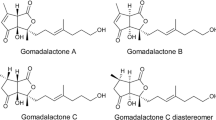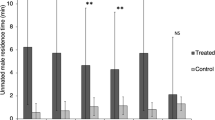Abstract
The courtship behaviour of male Spodoptera exempta (Wlk.) has been quantified and used as a method of bioassay for the female sex pheromone. Virgin females become attractive to sexually mature males from 72 hr after emergence and henceforth their attractiveness increases gradually until they have mated. Mated females start losing their attractiveness to males gradually after mating and 72–96 hr after mating they cannot produce any courtship response in males. Amongst virgin females, crude pheromonegland extract and synthetic pheromone compounds, it is the older live females and the crude extract at 0.1 female equivalent that produce highest responses in males. A certain degree of cross-attraction between three coexisting species has been noted, both by using live insects as well as synthetic pheromone compounds of these species under laboratory bioassays. Possible interspecific pheromone-related implications are discussed.
Similar content being viewed by others
References
Beevor P. S., Hall D. R., Lester R. G., Read J. S. and Nesbitt B. F. (1975) Sex pheromones of the armyworm moth, Spodoptera exempta (Wlk.). Experientia 31, 22–23.
Blair B. W. and Tannock J. (1978a) A further note on the possible pheromone for Spodoptera triturata (Wlk.) (Lepidoptera: Noctuidae). Rhod. J. agric. Res. 16, 221–223.
Blair B. W. and Tannock J. (1978b) Observation of interspecific attraction by mated females of Spodoptera triturata (Wlk.) (Lepidoptera: Noctuidae). Rhod. J. agric. Res. 16, 225–227.
Brady E. U. and Gaynard M. C. Jr (1972) Identification of a sex pheromone of the female beet armyworm, Spodoptera exigua. Ann. ent. Soc. Am. 63, 898–899
Brown E. S., Betts E. and Rainey R. C. (1969) Seasonal changes in the distribution of the African armyworm, Spodoptera exempta (Wlk.) (Lepidoptera: Noctuidae) with special reference to eastern Africa. Bull. ent. Res. 58, 661–728.
Brown E. S. and Dewhurst C. F. (1975) The genus Spodoptera (Lepidoptera: Noctuidae) in Africa and the near east. Bull. ent. Res. 65, 221–262.
Campion D. G. (1975) Sex pheromones and their uses for control of insects of the genus Spodoptera. Meded. Fac. Landb. Rijksuniv. Gent. 40, 283–292.
Evans L. J. (1952) Female Aretia cacia L. attracting other Arctinae. Ent. Rec. 64, 86.
Gaynard M. C. Jr and Brady U. E. (1972) Interspecific attraction in Lepidoptera in the field. Ann. ent. Soc. Am. 56, 1279–1282.
Grant G. G. (1975) Extraction and bioassay of female sex pheromone of white-marked tussock moth, Oryia lencostigma (Lepidoptera: Lymantridae). Can. Ent. 107, 303–309.
Kaae R. S., Shorey H. H., McFarland S. U. and Gaston L. K. (1973) Sex pheromones of Lepidoptera. XXXVII. Role of sex pheromones and other factors in reproductive isolation among ten species of Noctuidae. Ann. ent. Soc. Am. 66, 444–448.
Khasimuddin S. (1979) Courtship and mating behaviour of the African armyworm, Spodoptera exempta (Wlk.), (Lepidoptera: Noctuidae). Bull. ent. Res. 68, 195–202.
Klun J. A. and Robinson J. F. (1972) Olfactory discrimination in the European corn borer, and several pheromonally analogous moths. Ann. ent. Soc. Am. 65, 1337–1340.
Mitchell E. R. (1976) Mating specificity in Spodoptera spp. Florida Entomologist 59, 416.
Mitchell E. R. (1982) Attraction of Schinia mitis males to southern armyworm females. Florida Entomologist 65, 291.
Nielson D. G. and Balderston C. P. (1973) Evidence of inter-generic sex attraction among aegeriids. Ann. ent. Soc. Am. 66, 227.
Roelofs W. L. and Comeau A. (1969) Sex pheromone specificity: taxonomic and evolutionary aspects of Lepidoptera. Science 165, 398–400.
Saunders C. J. (1971) Sex pheromone specificity and taxonomy of budworm moths (Choristoneura). Science 171, 911–913.
Sekul A. A, and Sparks A. N. (1967) Sex pheromones of the fall armyworm moth: isolation, identification and synthesis. J. econ. Ent. 60, 1270–1272.
Shorey H. H., Gaston L. K. and Fukuto T. R. (1964) Sex pheromones of noctuid moths. I. A quantitative bioassay for the sex pheromone of Trichoplusia ni (Lepidoptera: Noctuidae). J. econ. Ent. 57, 252–254.
Tamaki Y., Noguchi H. and Yushima T. (1973) Sex pheromone of Spodoptera litura (F.): Isolation, identification and synthesis. Appl. ent. Zool. 8, 200–203.
Tamaki Y. and Yushima T. (1974) Sex pheromone of the cotton leafworm, Spodoptera littoralis. J. Insect Physiol. 20, 1005–1014.
Author information
Authors and Affiliations
Rights and permissions
About this article
Cite this article
Khasimuddin, S., Lubega, M.C. Quantitative Bioassays for Sex Pheromone Analysis in Spodoptera Exempta (Wlk.) (Lepidoptera, Noctuidae), and Laboratory Evidence of Cross-Attraction among Three Species. Int J Trop Insect Sci 5, 325–328 (1984). https://doi.org/10.1017/S1742758400001636
Received:
Revised:
Published:
Issue Date:
DOI: https://doi.org/10.1017/S1742758400001636




